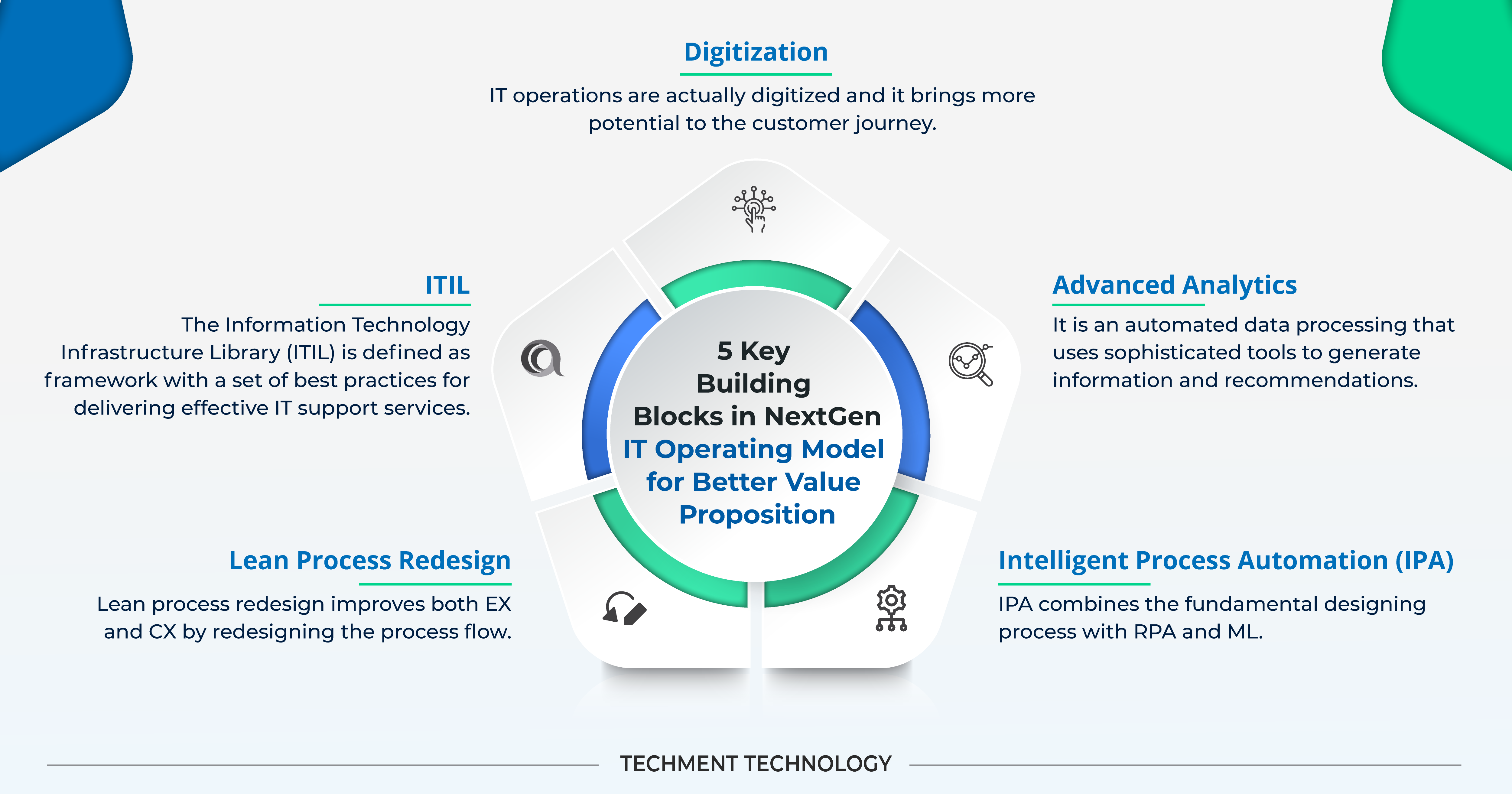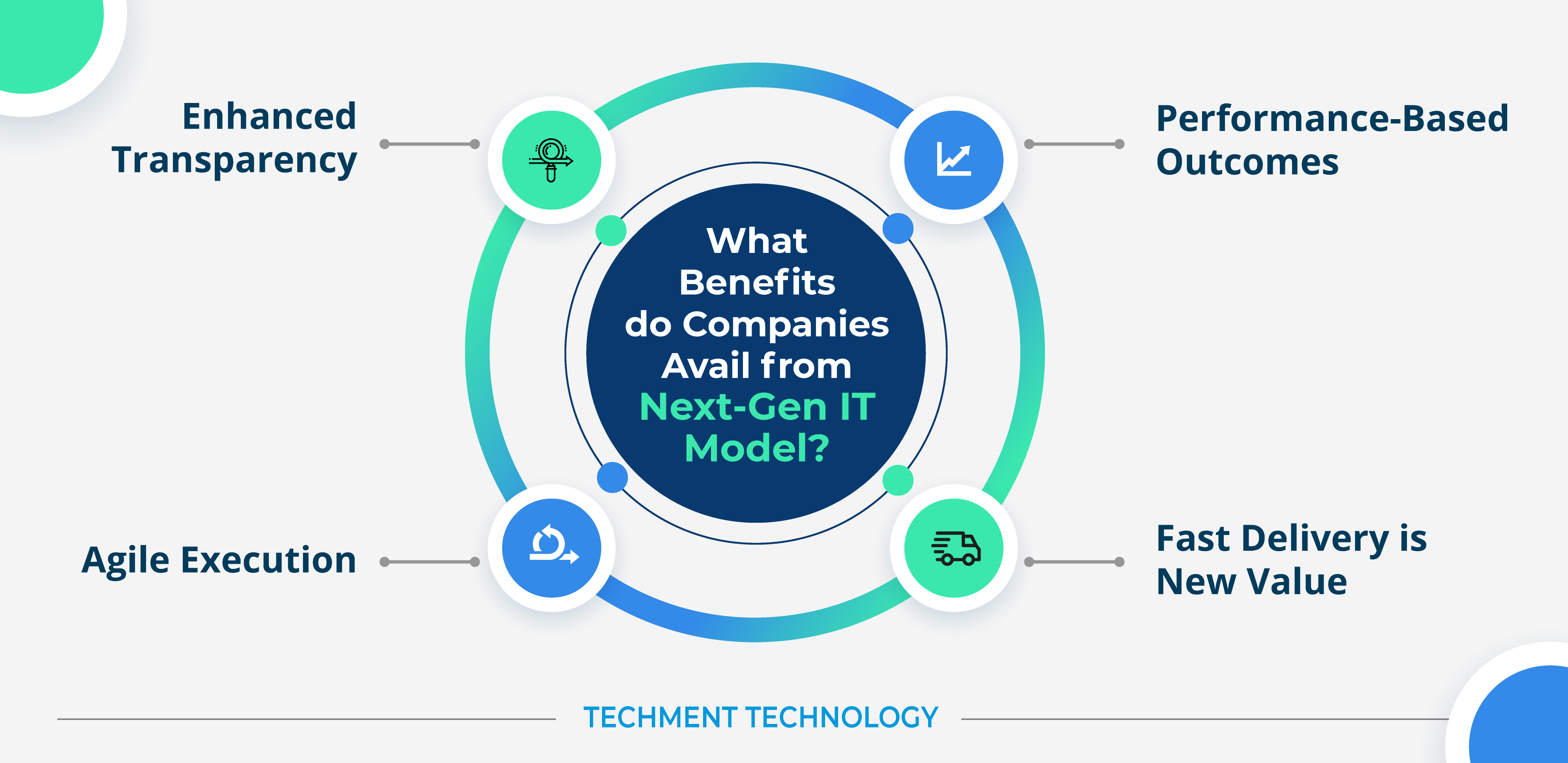New Operating Model is About Continuous Change
The traditional IT operating model consists of core business capabilities with support groups, processes, and technologies for delivering application management services aligned with an internal line of business (LoB). This legacy system consists of organizational structure, operating model, and execution but this model doesn’t resonate with business visions because IT functions are inclined towards technical competencies. This develops the need for NextGen IT operating model for transformation in the application management systems (AMS) which has to be adopted at atomic levels in the organization.
AMS is open to changes that allow companies to move towards innovation, improves resiliency and performance resulting in reduced cost, improves predictability, and enhances the consumer experience. Application management services (AMS) provides a coherent and robust environment to leverage new technologies like AI, ML, DevOps, IoT, blockchain, smart technologies, etc. to help attain the technical vision and bring change in the entire business model. A shift in the current IT operating model is key to achieving greater speed, flexibility, greater time to market, and optimizing operations.
Most traditional operating models cannot handle continuous change but the influence of the NextGen IT operating model is so great that companies may have to change their core business models in order to survive.
5 Key Building Blocks in NextGen IT Operating Model for Better Value Proposition
For successful transformation in business, the pattern of the operating model needs to be reconfigured. To keep pace with current trends in technologies, companies must incorporate emerging technologies like AI, ML, cloud, and other automation, adding agility and speed to business operations.

These key blocks will add values to the IT operating model:
1. Digitization: When new tools and technologies are involved in the business journey, IT operations are actually digitized and it brings more potential to the customer journey. This reshapes the time-consuming tasks in internal processes, especially where multiple systems are involved. Tightly integrated digital strategies will create differences between competitors, with the greatest rewards going to those who cause disruptions.
2. Advanced Analytics: It is an automated data processing that uses sophisticated tools to generate information and recommendations.
DAaaS: By harnessing the new trends in data growth and proliferation organizations can take a shift towards a data analytics-as-a-service (DAaaS) model from a product-based model. Data Analytics-as-a-Service (DAaaS) allows various tools for data analytics to be configured by users to access heterogeneous data. In addition, it extends the traditional approach with innovative concepts such as analytics apps and related analytic app stores.
In DAaaS, customers feed their data and back more concrete and useful analytical insights. These insights are generated from analytical apps whose workflow is built using machine learning algorithms.
3. Intelligent Process Automation (IPA): IPA combines the fundamental designing process with RPA and ML. The approach of IPA depends on higher-level automation which can also take bigger tasks like tracking the end-to-end process in real-time. The ML does predictions based on inputs and provides insights on recognized patterns. IPA is often confused with RPA, where RPA is just a subcategory of IPA that functions to automate repetitive tasks. The technologies used in IPA are:
- RPA: This automates the rule-based repetitive task and reduces the queue procedures and avoids human intervention.
- Smart Workflow: It is a process management software tool that allows users to track the status of the end-to-end processes in real-time and provide statistical data.
- ML: Algorithms identifying the patterns in structured data through supervised and unsupervised learning are done by ML.
- NLG (Natural Language Generator): The software engine that seamlessly creates interaction between humans and technology by translating observed data into prose. Structured performance data is fed into NLG to create reports.
- Cognitive Agent: The combination of machine language and NLG is called a cognitive agent to build a virtual workforce, capable of executing tasks, communicating, and learning from data sets.
4.Lean Process Redesign: When counting on customer experience (CX), here are three poor elements often seen i.e., heavy processes, disconnected system, and siloed department which results in bad employee experience (EX) and ultimately bad CX. Lean process redesign improves both EX and CX by redesigning the process flow.
5. ITIL: The Information Technology Infrastructure Library (ITIL) is defined as a framework with a set of best practices for delivering effective IT support services. It enables organizations and individuals to provide profitable IT service management (ITSM) in line with business vision, strategy, and growth and acts as a point of contact between service providers and end-users. While ITSM helps companies achieve their mission and vision through the right mix of processes, technology, and people, ITIL guides the management and delivery of IT services.
Digital transformation and technology initiatives are guided by the best practices of ITIL. It strives to optimize resources, continually review existing processes for improvement, and also acts as your business partner for organizations that only apply the methods that suit them.
NextGen’s IT operating model can support cost savings, high availability, flexibility to compress and scale, reduce risk, and accelerate time to market. The significant changes are seen in the ways of communication. With the NextGen operating model, IT, business, and operations are becoming increasingly interoperable.
What Benefits do Companies Avail from Next-Gen IT Model?
In today’s increasingly user-driven environment, IT organizations are expected to be much more agile and responsive than in the past. IT companies are growth enablers and their practice of adopting new technology brings proliferation in business models, communication channels, and cost structures. The benefits of new IT operating models can be seen with these attributes:

- Enhanced Transparency: IT stakeholders have a close watch on all IT operations like programs, projects, costs, and consumptions. Hence, enhances transparency.
- Agile Execution: Shorter time to market for new ideas requires a change in IT operating models, increased speed and flexibility which requires new forms of collaboration between business and IT. With the digital age, the gap between IT strategy and business strategy is blurring. The introduction of agile at scale means intertwining business and IT which implies a fundamental change of the entire operating model. From a technology perspective, an organization requires a robust functional architecture that enables modularity and continuous delivery through IT for IT automation. In addition, new capabilities must be built on flexible tools and working methods.
- Fast Delivery is New Value: A long-drawn-out solution was accepted previously but now the delivery of solutions and values are needed fast. The new IT model comes to accelerate the delivery of solutions and reduce the time to value (TVV).
- Performance-Based Outcomes: IT is moving more towards delivering end-to-end service quality and directly contributing to business values like revenue growth, customer experience, margin improvement, and others, rather than just working for delivery.
Many IT organizations have invested heavily in application development capabilities, and some have even created or acquired resources overseas. As a result, thousands of custom applications are built into the IT portfolio. The new model shifts the focus from custom application manufacturing to outsourcing and service integration to deliver new capabilities faster and at a lower cost.
Technology will Provide New Capabilities to NextGen Operating Models
Companies must take a customer-centric approach to transform applications, working closely with product management teams to get the right functionality needed for their product or application.
With technological advancements, a paradigm shift comes for operating models with NextGen technologies. Moving from a traditional operating model to NextGen offers flexible cross-functional teams (business and IT) and product owners playing key roles. Technologies are more organized and integrated into the business (especially application development and maintenance), creating and driving new technological capabilities that can support operating models. While the transition from the traditional way of working to NextGen is well underway, it needs considerable time to get started, developed, and mastered.
 All Posts
All Posts
